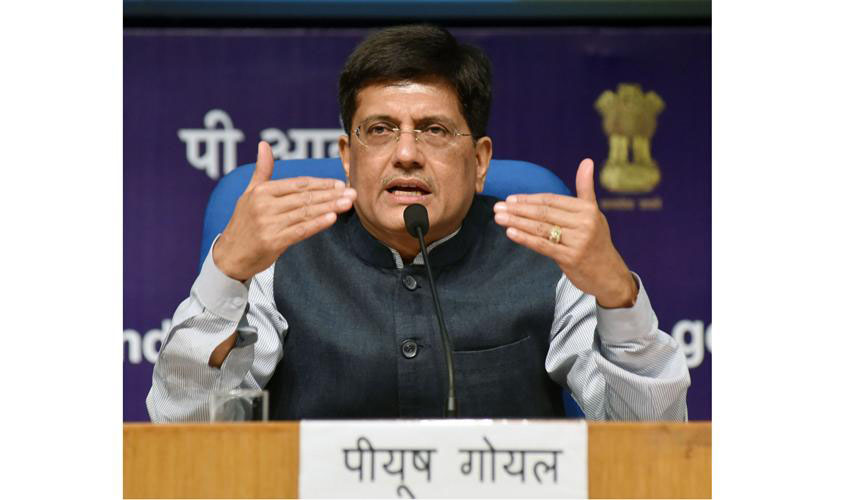 Days before the Cabinet reshuffle, commentators and journalists were betting on Piyush Goyal’s elevation. In consonance with the buzz, Prime Minister Narendra Modi promoted Goyal to Cabinet rank and also gave him the prestigious and politically important Ministry of Railways.
Days before the Cabinet reshuffle, commentators and journalists were betting on Piyush Goyal’s elevation. In consonance with the buzz, Prime Minister Narendra Modi promoted Goyal to Cabinet rank and also gave him the prestigious and politically important Ministry of Railways.Interestingly, Piyush Goyal’s claims of solid work at the Ministry of Power were bolstered by none other than scientists at the United States’ space agency, National Aeronautics and Space Administration (NASA). Images clicked by NASA’s Suomi-NPP satellite, released in April 2017, showed that night time lights in India had increased significantly between 2012 and 2016. Increased night light at countries in the planet was depicted in blue and dimmed areas in pink. With a splash of blue spread throughout, India looked much brighter in 2016 as compared to 2012. Later, basing her source on these NASA night time maps, Betsy Mason blogged on the National Geographic dated 29 April 2017, “That India has brightened dramatically, is not a surprise.”
Has India’s “power” story picked up dramatically over the last three years or so?
About 60,000 MW of capacity has been added in conventional energy alone; the highest ever for a period of three years and representing an increase of over one-fourth from capacity installed till March 2014. And has this increased capacity led to greater conventional energy generation? As per Central Electricity Authority (CEA) data, energy generation from conventional sources has increased at a fairly decent rate over the last three years, that is, 8.43% in 2014-15, 5.64% in 2015-16 and 4.72% in 2016-17.
And it is on the back of this rising power generation capability that the Union Government steadily constructed cross-border electrical lines, enabling India to become for the first time a net exporter of electricity. As per CEA data, during the first 11 months of FY 2016-17, India exported around 5,798 million units of electricity to Nepal, Bangladesh and Myanmar, which is 213 million units more than the import of around 5,585 million units from Bhutan. Export of electricity to Nepal and Bangladesh increased by 2.5 times and 2.8 times, respectively, during the last three years or so.
Another achievement of Piyush Goyal has been the successful implementation of the Deendayal Upadhyay Gram Jyoti Yojna (DDUGJY), a replica of the pioneering Jyotigram Yojna that Narendra Modi had executed in his tenure as Gujarat’s Chief Minister. Launched by the PM on 25 July 2015, the DDUGJY is a rural electrification scheme that focuses on feeder separation (rural households and agricultural consumers) and strengthening of sub-transmission and distribution infrastructure, so as to provide 24X7 power to rural households and adequate power to farmers.
As per data submitted by states, 18,452 villages were not electrified as on 1 April 2015. Out of this, 13,511 villages have been electrified under the DDUGJY as on 19 May 2017—by no means a mean and swift achievement. Likewise, the DDUGJY proposed to provide electricity connections to about 4.5 crore un-electrified households by 2022; as per Power Ministry data as of April 2017, in under two years, of this nearly 2.6 crore households have been given free electricity connections. It may be underscored that between 2005, when the Rajiv Gandhi Grameen Vidyutikaran Yojna was launched and 2013; in a period of eight years, just a little over 2 crore households were provided free electricity connections. Likewise, the DDUGJY has monitored well the quality and quantity of power in rural areas, by putting in place a rural feeder monitoring scheme that covers all 1 lakh rural and farm feeders.
The UJALA (Unnat Jyoti by affordable LEDs for All) initiative is another success story. The world’s largest LED distribution programme, over 23 crore LED bulbs were distributed under UJALA across the country in three years wherein two free of cost LED bulbs were given to villagers. Not only would this brighten homes, it is estimated that consumers would save huge amounts in their electricity bills.
Another area where Goyal invested his attention and resources is clean energy—a pet theme of his boss, Prime Minister Narendra Modi. The Renewable Energy department saw a six-fold increase in its budget in 2016-17, from Rs 1,500 crore to Rs 9,000 crore. A total of 7,060 MW of grid connected renewable power capacity was added in 2015-16, far exceeding the target of 4,460 MW. The same year witnessed the largest ever addition to wind power capacity—of 3,423 MW, exceeding the target by 43%. It also saw the biggest ever increment to solar capacity, when 3,019 MW was added, exceeding the targets by 116%. Astonishingly, 2016-17 saw for the first time ever net capacity addition of renewable power exceeding that of conventional power. Clearly, the foundations of a greener tomorrow are being put in place assiduously by the NDA government.

